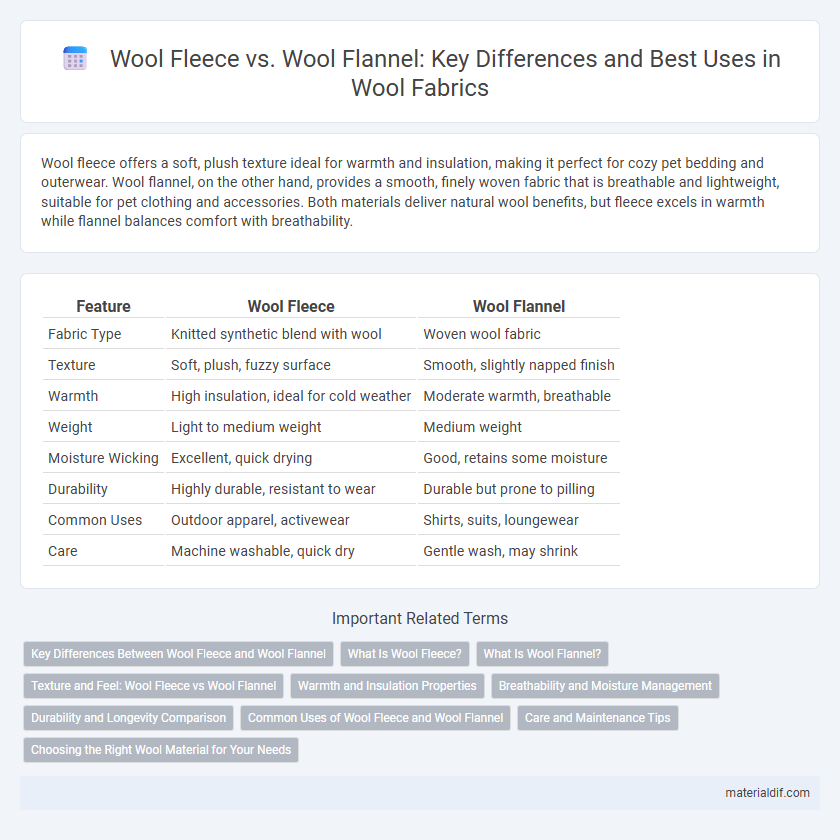Wool fleece offers a soft, plush texture ideal for warmth and insulation, making it perfect for cozy pet bedding and outerwear. Wool flannel, on the other hand, provides a smooth, finely woven fabric that is breathable and lightweight, suitable for pet clothing and accessories. Both materials deliver natural wool benefits, but fleece excels in warmth while flannel balances comfort with breathability.
Table of Comparison
| Feature | Wool Fleece | Wool Flannel |
|---|---|---|
| Fabric Type | Knitted synthetic blend with wool | Woven wool fabric |
| Texture | Soft, plush, fuzzy surface | Smooth, slightly napped finish |
| Warmth | High insulation, ideal for cold weather | Moderate warmth, breathable |
| Weight | Light to medium weight | Medium weight |
| Moisture Wicking | Excellent, quick drying | Good, retains some moisture |
| Durability | Highly durable, resistant to wear | Durable but prone to pilling |
| Common Uses | Outdoor apparel, activewear | Shirts, suits, loungewear |
| Care | Machine washable, quick dry | Gentle wash, may shrink |
Key Differences Between Wool Fleece and Wool Flannel
Wool fleece is a soft, thick, and insulating fabric with a brushed texture that provides excellent warmth and moisture-wicking properties, making it ideal for activewear and cold-weather clothing. Wool flannel, in contrast, is a smoother, tightly woven fabric with a soft nap, known for its durability, warmth, and classic appearance, often used in shirts and suits. The key differences lie in texture--fleece being fluffier and more porous, and flannel being denser and smoother--affecting their breathability, insulation, and style applications.
What Is Wool Fleece?
Wool fleece is a soft, insulating fabric made from the outer coat of sheep, known for its durability and moisture-wicking properties. Unlike wool flannel, which is woven and has a smooth finish, wool fleece is knitted or brushed to create a fluffy texture that traps heat effectively. Its thermal insulation and breathability make wool fleece ideal for cold-weather apparel and outdoor gear.
What Is Wool Flannel?
Wool flannel is a soft, woven fabric made from carded wool fibers, known for its smooth finish and lightweight warmth, ideal for shirts and suits. Unlike wool fleece, which is a thick, napped material providing high insulation, wool flannel offers a finer texture with moderate warmth and breathability. Fabric manufacturers favor wool flannel for its durability and elegant drape, making it a popular choice in tailored garments and cold-weather apparel.
Texture and Feel: Wool Fleece vs Wool Flannel
Wool fleece offers a soft, plush texture with a thick, insulating feel that provides exceptional warmth and comfort, making it ideal for cold weather. Wool flannel features a smoother, denser weave with a slightly crisp yet soft touch, providing a lightweight, breathable fabric suited for layering. The tactile difference lies in fleece's fluffy loft versus flannel's fine, closely woven surface, affecting both warmth retention and wearability.
Warmth and Insulation Properties
Wool fleece provides superior warmth and insulation due to its thick, dense fibers that trap heat effectively, making it ideal for cold weather layers. Wool flannel, while softer and lighter, offers moderate insulation with a smooth texture that retains warmth but is more breathable than fleece. Both materials leverage natural lanolin and crimped wool fibers to maintain body heat, but fleece excels in thermal retention for harsher conditions.
Breathability and Moisture Management
Wool fleece offers exceptional breathability due to its lofted fibers that trap air, providing warmth while allowing moisture to evaporate efficiently. Wool flannel, with its tighter weave, offers moderate breathability but excels in moisture-wicking, drawing sweat away from the skin to keep the wearer dry. Both fabrics manage moisture well, yet wool fleece is better suited for high-activity wear, while wool flannel is ideal for cooler, less strenuous conditions.
Durability and Longevity Comparison
Wool fleece offers superior durability due to its dense, tightly knit fibers that resist pilling and wear, making it ideal for high-activity use and outdoor garments. Wool flannel, while softer and more breathable, tends to be less durable over time because its looser weave is more prone to abrasion and thinning. For longevity, wool fleece consistently outperforms wool flannel, maintaining its structural integrity and insulating properties through extended use and frequent washing.
Common Uses of Wool Fleece and Wool Flannel
Wool fleece is commonly used in outdoor apparel and blankets due to its exceptional warmth, moisture-wicking properties, and lightweight insulation ideal for cold weather activities. Wool flannel is frequently chosen for tailored clothing such as suits, shirts, and skirts because of its soft texture, fine weave, and breathable yet insulating qualities suitable for both casual and formal wear. Both materials leverage wool's natural durability and temperature regulation but serve distinct purposes based on fabric finish and end-use requirements.
Care and Maintenance Tips
Wool fleece requires gentle washing in cold water and air drying to prevent shrinking and maintain softness, while wool flannel needs similar care with extra caution to avoid pilling and preserve its smooth finish. Both fabrics benefit from using mild detergent formulated for wool and should be stored in a cool, dry place to prevent moth damage. Regular brushing with a soft clothes brush helps maintain fiber integrity in flannel, whereas fleece benefits from occasional airing to retain loft and breathability.
Choosing the Right Wool Material for Your Needs
Wool fleece offers superior warmth and softness, making it ideal for outdoor activities and cold weather clothing due to its insulating properties and moisture-wicking ability. Wool flannel provides a smoother, lighter texture with excellent breathability, suited for casual wear and tailored garments where comfort and style are priorities. Selecting between wool fleece and wool flannel depends on your specific requirements for insulation, texture, and garment type.
Wool Fleece vs Wool Flannel Infographic

 materialdif.com
materialdif.com